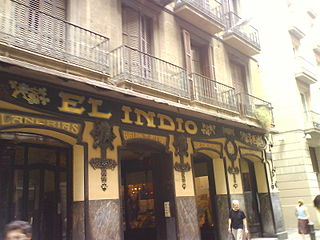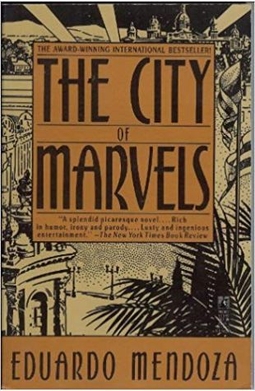Related Research Articles

For Whom the Bell Tolls is a novel by Ernest Hemingway published in 1940. It tells the story of Robert Jordan, a young American volunteer attached to a Republican guerrilla unit during the Spanish Civil War. As a dynamiter, he is assigned to blow up a bridge during an attack on the city of Segovia.

Camilo José Cela y Trulock, 1st Marquess of Iria Flavia was a Spanish novelist, poet, story writer and essayist associated with the Generation of '36 movement.

Manuel Vázquez Montalbán was a prolific Spanish writer from Barcelona: journalist, novelist, poet, essayist, anthologue, prologist, humorist, critic and political prisoner as well as a gastronome and a FC Barcelona supporter.

Carmen Laforet was a Spanish author who wrote in the period after the Spanish Civil War. An important European writer, her works contributed to the school of Existentialist Literature and her first novel Nada continued the Spanish tremendismo literary style begun by Camilo José Cela with his novel, La familia de Pascual Duarte. She received the Premio Nadal in 1944.

Spanish literature generally refers to literature written in the Spanish language within the territory that presently constitutes the Kingdom of Spain. Its development coincides and frequently intersects with that of other literary traditions from regions within the same territory, particularly Catalan literature, Galician intersects as well with Latin, Jewish, and Arabic literary traditions of the Iberian peninsula. The literature of Spanish America is an important branch of Spanish literature, with its own particular characteristics dating back to the earliest years of Spain’s conquest of the Americas.

Libra is a 1988 novel by Don DeLillo that describes the life of Lee Harvey Oswald and his participation in a fictional CIA conspiracy to assassinate President John F. Kennedy. The novel blends historical fact with fictional supposition.
Felipe Alfau was a Spanish-born American novelist and poet. Most of his works were written in English.

Javier Marías Franco was a Spanish author, translator, and columnist. Marías published fifteen novels, including A Heart So White and Tomorrow in the Battle Think on Me. In addition to his novels, he also published three collections of short stories and various essays. As one of Spain's most celebrated novelists, his books have been translated into forty-six languages and were sold close to nine million times internationally. He received several awards for his work, such as the Rómulo Gallegos Prize (1995), the International IMPAC Dublin Literary Award (1997), the International Nonino Prize (2011), and the Austrian State Prize for European Literature (2011).

Jorge Semprún Maura was a Spanish writer and politician who lived in France most of his life and wrote primarily in French. From 1953 to 1962, during the dictatorship of Francisco Franco, Semprún lived clandestinely in Spain working as an organizer for the exiled Communist Party of Spain, but was expelled from the party in 1964. After the death of Franco and change to a democratic government, he served as Minister of Culture in Spain's socialist government from 1988 to 1991.

El Raval is a neighborhood in the Ciutat Vella district of Barcelona, the capital city of Catalonia. The neighborhood, especially the part closest to the old port, was formerly (informally) known as Barri Xinès or Barrio Chino, meaning "Chinatown". El Raval is one of the two historical neighborhoods that border La Rambla, the other being the Barri Gòtic; it contains some 50,000 people.

Don Winslow is an American retired author best known for his award-winning and internationally bestselling crime novels, including Savages, The Force and the Cartel Trilogy.

Edgardo Vega Yunqué was a Puerto Rican novelist and short story writer, who also used the Americanized pen name Ed Vega.

Eduardo Mendoza Garriga is a Spanish novelist.

Gabriel José de la Concordia García Márquez was a Colombian novelist, short-story writer, screenwriter, and journalist, known affectionately as Gabo or Gabito throughout Latin America. Considered one of the most significant authors of the 20th century, particularly in the Spanish language, he was awarded the 1972 Neustadt International Prize for Literature and the 1982 Nobel Prize in Literature. He pursued a self-directed education that resulted in leaving law school for a career in journalism. From early on he showed no inhibitions in his criticism of Colombian and foreign politics. In 1958, he married Mercedes Barcha Pardo; they had two sons, Rodrigo and Gonzalo.

Emili Teixidor i Viladecàs was a Catalan writer, journalist and pedagogue. He wrote over thirty novels, mainly for children and teenagers, but he is perhaps best known for his acclaimed adult novel, Black Bread, which inspired a film of the same name.

Juan Gabriel Vásquez is a Colombian writer, journalist and translator. He has written many novels, short stories, literary essays, and numerous articles of political commentary.

Yo-Yo Boing! (1998) is a postmodern novel in English, Spanish, and Spanglish by Puerto Rican author Giannina Braschi. The cross-genre work is a structural hybrid of poetry, political philosophy, musical, manifesto, treatise, memoir, and drama. The work addresses tensions between Anglo-American and Hispanic-American cultures in the United States.

The City of Marvels is a 1986 historical fiction Spanish novel written by Eduardo Mendoza Garriga about the city of Barcelona and its cultural evolution during the turn of the 20th century. Its central character, Onofre Bouvila, represents a lower class character and their collective ideology.

Tres tristes tigres, abbreviated as TTT, is the debut novel by Cuban writer Guillermo Cabrera Infante. The novel was first published in Spain in 1967. It was later translated into English by Donald Gardner and Suzanne Jill Levine and published in 1971 as Three Trapped Tigers.

A Long Petal of the Sea is a 2019 novel by Chilean author Isabel Allende. Originally published in Spain by Plaza & Janés, it was first published in the United States by Vintage Espanol. The novel was issued in 2019 in Spanish as Largo pétalo de mar, and was translated into English by Nick Caistor and Amanda Hopkinson. Told through fictional characters in the context of real historical events, the story takes place partly during the Spanish Civil War and partly in Chile where the protagonists again witness the fight between freedom and repression. A Long Petal of the Sea became the most popular book in Spain between April 2019 and April 2020.
References
- 1 2 3 "The Truth about the Savolta Case". Kirkus Reviews . 15 May 1992. Retrieved 9 January 2024.
- 1 2 Encyclopedia of Contemporary Spanish Culture. 1999. p. 330. ISBN 9780415131872.
- ↑ Luciani, Frederick (29 November 1992). "Beat Up, Blown Up and Blown Away". The New York Times . Retrieved 9 January 2024.